![]()
![]()
![]()
Use LEFT and RIGHT arrow keys to navigate between flashcards;
Use UP and DOWN arrow keys to flip the card;
H to show hint;
A reads text to speech;
162 Cards in this Set
- Front
- Back
|
What are the three types of neurones? |
1. sensory neurons- transmit nerve impuleses from receptors to the central nervous system 2. motor neurons- transmit nerve impulses from the CNS to effectors 3. relay neurons- transmit nerve impulses between sensory neurons and motor neurons |
|
|
Describe the pathway of nervous communication |
Stimulus receptor sensory neuron CNS motor neurone effectors response |
|
|
What is the resting potential of the sensory receptors? |
Resting potential- the inside of the cell is negatively charged relative to the outside means there is a potential difference across the membrane generated by ion pumps and ion channels |
|
|
What is generator potential? |
when a stimulus is detected the cell membrane is excited becomes more permeable more ions move in and out of cell altering pot. difference |
|
|
What is the action potential? |
If generator potential is big enough it will trigger an action potential along a neurone. only triggered if generator potential reaches threshold level |
|
|
Why do you not always notice your clothes on your skin? |
If stimulus is too weak the generator potential wont reach the threshold level so there is no action potential. |
|
|
What are Pacinian Corpuscles? |
mechanoreceptors- detect mechanical stimuli such as pressure and vibrations found in skin sensory nerve ending wrapped in lamellae |
|
|
How do Pacinian Corpsules work? |
when stimulated the lamellae are deformed and press on sensory nerve ending. this causes deformation of stretch-mediated sodium channels in cell membrane sodium channels open and sodium ions diffuse in to cell creates generator potential if it reaches threshold an action potential is triggered |
|
|
What are nerve impulses? |
an electrical charge transmitted along a neurone created by the movement of sodium and potassium ions across neurone call membrane |
|
|
What is the resting membrane potential? |
outside of membrane is positively charged compared to the inside more positive ions outside the cell membrane is polarised -70mv |
|
|
How is the resting membrane potential maintained? |
Sodium potassium pumps use active transport to move 3 sodium ions out of the neurone for every 2 potassium moved in. ATP needed. creates electrochemical gradient Potassium ion channels allow facilitated diffusion of potassium ions out of the neurone at rest more potassium ion channels are open |
|
|
Describe the steps in an action potential. |
1. Stimulus- excites cell membrane causing Na+ channels to open. Membrane is more permeable to Na+ so diffuse in . inside neurone=less negative 2.Depolarisation-if potential difference reaches threshold voltage gated Na+ channels open. more Na+ goes in- POSITIVE FEEDBACK 3.Repolarisation- at +30mv Na+ channels close and voltage gated K+ open, so diffuse in. membrane returns to resting potential 4.Hyperpolarisation- K+ channels are slow to close so too many K+ diffuse out. Potential difference is more negative than resting potential 5.Resting Potential- ion channels are reset |
|
|
What is the refractory period? |
After and action potential the neurone cell membrane can't be excited again straight away because ion channels are recovering. Acts as a time delay between one action potential and the next. makes sure AP's don't overlap makes sure AP's are unidirectional |
|
|
What is a wave of depolarisation? |
when AP happens some sodium ions that enter diffuse sideways. This causes sodium ion channels in the next region of the neurone to open and Na+ diffuses in. Electrical impulses propagates along the neurone |
|
|
What is the all or nothing nature of action potentials? |
Once threshold is reached an action potential will always fire with the same change in voltage, no matter how big the stimulus is. A bigger stimulus wont cause a bigger action potential, but will cause them to fire more frequently |
|
|
What factors affect the speed of conduction of action potentials? |
1.Myelination- myelin sheath made of Schwann cells is an electrical insulator. Depolarisation only happens at nodes of ranvier so the impulse jumps from node to node-SALTATORY CONDUCTION 2.Axon diameter- bigger diameter means less resistance to the flow of ions in the cytoplasm so depolarisation reaches other part of cell membrane faster 3.Temperature-warmer- ions diffuse fast. Only increases to 40'C because protiens begin to denature |
|
|
What is a synapse? |
the junction between a neurone and another neurone or effector cell |
|
|
What is a cholinergic synapse? |
uses the neurotransmitter acetylcholine (ach) which binds to cholinergic recpetors |
|
|
How is a nerve impulse transmitted across a cholinergic synapse? |
1.action potential arrives at pre-synaptic knob. AP stimulates voltage-gated Ca2+ to open, so Ca2+ diffuse into the synaptic knob 2. influx of Ca2+ causes synaptic vesicles to move to the presynaptic membrane and release ACh by exocytosis 3. ACh diffuse across the synaptic cleft and binds to specific receptors on post synaptic membrane causes Na+ channels to open. Influx of ions causes depolarization action potential is generated if threshold is reached |
|
|
How is ACh removed from the synaptic cleft? |
removed so response doesn't keep happening broken down by enzyme acetylcholinease products reabsorbed by presynaptic neurone used to make more ACh |
|
|
What are agonist chemicals and give an example? |
Chemical is same shape as neurotransmitter so mimic action at receptors e.g Nicotine mimics acetyylcholine |
|
|
What other factors disrupt synaptic transmission? |
-mimic action at receptors -block receptors so cant be activated -inhibit enzyme that breaks down neurotransmitter -inhibit release of neurotransmitters from presynaptic neurone so fewer receptors are activated |
|
|
What is synaptic divergence? |
when one neurone connects to many neurones information can be dispersed to different parts of the body |
|
|
What is synaptic convergence? |
When many neurones connect to one neurone information can be amplified |
|
|
What is summation? |
the effect of neurotransmitters released from many neurones is added together means synapses accurately process information, finely tuning the response |
|
|
What are the two types of summation? |
1. Spatial summation-two or more presynaptic neurones converge and release their neurotransmitters at the same time on the same post synaptic neurone. allow signals from multiple stimuli to be coordinated in a single response 2.Temporal Summation-where two or more nerve impulses arrive in quick succession from the same presynaptic neurone. Action potential more likely because more neurotransmitter is released into synaptic cleft |
|
|
What is unidirectional transmission? |
nervous impulse only travels in one direction because neurotransmitters are only released from presynaptic neurone. |
|
|
What is a hormone? |
A chemical messenger Secreted directly in the blood when a gland is stimulated Transported in blood plasma and diffuse out, binding to specific receptors on target cells |
|
|
What is a steroid hormone? |
E.g oestrogen Lipid soluble Passes through lipid component of cell and binds to receptors Hormone-receptor complex acts as transcription factor which facilitates transcription of certain genes |
|
|
What is a non steroid hormone? |
E.g adrenaline Hydrophobic Can't pass directly through membrane Binds to specific receptors on membrane |
|
|
Describe the action of adrenaline and the function |
Function- trigger liver cells to undergo glycogenolysis so glucose is released into blood stream Secretes from adrenal glands when there is a low glucose concentration Is a first messenger, binding to specific recpetors on cell membranes. Activates enzyme in membrane (adenylyl cyclase). Stimulates production of second messenger cAMP Activates a cascade of enzyme reactions turning glycogen in to glucose |
|
|
What are adrenal glands? |
Endocrine glands that are found above kidney Cortex secretes steroid hormones when stressed. Cortisol regulates metabolism by stimulating breakdown of fats, Aldosterone control blood pressure, androgen suppress immune system Medulla secretes catecholamine hormones when sympathetic nervous system is stimulated. Adrenaline increases heart rate and blood glucose Noradrenaline widens pupils and air passages |
|
|
What is the role of the pancreas? |
Controlling blood glucose concentration |
|
|
What is the pancreas role as an exocrine gland? |
Produces digestive enzymes and al;Aline pancreatic juice Secreted in ducts and released in to duodenum |
|
|
What is pancreas role as a endocrine gland? |
Produces glycagon and insulin to control blood glucose concentration |
|
|
What are the islets of langerhans? |
Areas in the pancreas that contain endocrine tissue Alpha cells produce glucagon Beta cella produce insulin |
|
|
What is the pancreas response to an increase in glucose levels? |
Detected by B cells In islets of langerhans In pancreas Secretes insulin in blood Travels around body Receptors on skeletal muscle, liver cells and adipose tissue Cells take up more glucose Glycogenesis is activates Cells respire more |
|
|
What is the pancreass response to decrease in blood glucose concentration? |
Detected by a cells In islets of langerhans In pancreas Secretes glucagon in blood B cells stop producing insulin Glycogenesis activated Gluconeogenesis is activates Cells respire less glucose |
|
|
What are the following?
-glycogenesis -gluconeogenesis -glycogenolysis |
1. Glucose in to glycogen 2. Fatty acids and amino acids to glucose 3. glycogen to glucose |
|
|
What happens at a normal blood glucose concentraion? |
When blood glucose level is normal K+ channels are open and Ca2+ channels are closed, so K+ diffuse out. Cell potential -70mv |
|
|
How is insulin secretion controlled by beta cells? |
When glucose concentration is high more glucose enters cell by active transport Glucose is metabolised by mitochondria= ATP ATP triggers K+ channels in B cell plasma membrane to close K+ can no longer diffuse out so potential difference is -30mv= depolarisation Triggers Ca2+ channels to open so enter cell Causes secretory vesicles to fuse with membrane and release insulin by exocyosis |
|
|
What causes an increase in blood glucose level? |
Diet- carbohydrates are broken down and absorbed by blood glycogenolysis- glycogen broken down into glucose gluconegenesis- production of glucose from noon carbohydrate sources |
|
|
What causes a decrease in blood glucose level? |
respiration- glucose used by cells to release energy glycogenesis- production of glycogen from glucose |
|
|
What is diabetes? |
condition where blood glucose concentration can't be controlled properly |
|
|
What is type 1 diabetes? |
auto immune disease, in which the body attacks and destroys the beta cells in the islets of Langerhans so patients dont produce insulin blood glucose rises and stays high after eating which can result in death kidneys cant absorb all of the glucose so some is excreted in urine |
|
|
How can you treat type 1 diabetes? |
insulin therapy- regular insulin injections insulin used to be taken from pigs and cows but could causes allergic reactions, now made from genetically modified bacteria can get islet cell transplantation, but also need additional therapy planned meals and exercise |
|
|
What are the advantages of insulin produced from genetically modified bacteria? |
insulin is pure people wont suffer allergic reactions produced in high quantities production is cheaper ethical and religious concerns are overcome |
|
|
What is type 2 diabetes? |
occurs when Beta cells dont produce enough insulin / bodys cells dont respond properly- glycoprotien receptor on cell membrane does not work result of excess body weight physical inactivity overeating of refined sugars being over 40 |
|
|
How do you treat type 2 insulin? |
Life style changes regulate carbohydrates intake and matching to exercise levels take drugs to stimulate insulin production and slow absorption |
|
|
What drugs can treat type 2 diabetes? |
Metformin-acts on liver cells to reduce amount of glucose they release in the blood. Increases sensitivity of cells to insulin Sulfonylureas- stimulate pancreas to produce more insulin Thaizolidinediones- make body cells sensitive to insulin |
|
|
How could you potentially cure diabetes? |
totipotent stem cells can grow into any cell type so may be able to trigger b cell production donor availability will not be an issue reduced likelihood of rejection people no longer have to inject insulin however stem cells might induce the formation of tumors as a result of unlimited cell growth |
|
|
What is homoeostasis? |
maintenance of constant internal environment |
|
|
What is negative feedback? |
effects respond to counteract the change- bringing the level back to norml |
|
|
What is positive feedback? |
amplifies the change. effectors respond to further increase the level away from the normal level |
|
|
What is an ectotherm? |
cant control their body temperature internally control temp by changing behaviour internal temp depends on temp of surroundings variable metabolic rate activity level depends on external temp |
|
|
What in an endotherm? |
control their body temperature internally by homoeostasis as well as altering their behaviour have high metabolic rate |
|
|
What behaviour things can an ectotherm do to warm up? |
increase radiation from sun by basking- orient bodies so max surface area is exposed e.g extend wings conduction- press bodies against warm ground exothermic metabolic reactions- contract muscles and vibrate to increase cellular metabolism |
|
|
What behavioural things can an ectotherm do to cool down? |
shelter from sun- hiding in cracks/ burrows conduction- press against cool rocks orient bodies so minimum surface area is exposed |
|
|
What physiological things can an ectotherm to to maintain body temperature? |
colour- dark colours absorb more radiation heart rate- increase or decrease metabolic rate to affect warming or cooling across body surfaces |
|
|
What can endotherms to cool down? |
vasodilation increased sweating- sweat spreads out across skin, sweat evaporates panting- animals with more hair lose heat when water evaporates from open mouth hair/ feathers large surface area to maximise cooling |
|
|
Describe vasodilation |
arterioles near surface of skin dilate
arterivenous shunt vessels constrict blood is forced through capillary network close to skin skin flushes and cools |
|
|
How can hairy animals cool down?? |
Erector pilli muscles relax hairs lie flat to skin avoids trapping insulating layer of air |
|
|
How to endotherms warm up? |
vasoconstriction
decreased sweating- sweat production stops reducing cooling by evaporation raising hair or feathers shivering- rapid involuntary contracting and relaxing large voluntary muscles- metabolic heat from exothermic reactions heat body reduced surface area insulating fat hibernation |
|
|
Describe vasoconstriction |
arterioles near surface of skin constrict arterivenous shunt vessels dilate very little blood flows near surface of skin skin pale little radiation occurs |
|
|
How would a hairy animal warm up? |
erector pilli muscles contract hair erect traps insulating layer of air reduces cooling |
|
|
How and where is thermoregulation controlled? |
maintained by hypothalamus HEAT LOSS CENTRE activated when blood temperature increases send impulses through autonomic motor neurones lowers core temp HEAT GAIN CENTRE activated when blood that flows through hypothalamus temp decreases raises core temperature |
|
|
What is a homeotherm? |
regulate body temperature about a set point |
|
|
What is a poikilotherm? |
cannot control own body temperature temperature changes with surroundings |
|
|
What is Bergmanns rule? |
animals in colder climates are usually larger than close relatives in warmer climates |
|
|
What is Allens rule? |
endotherms from cooler climates usually have shorter appendages than equivalent animals from warmer climates |
|
|
What is topor? |
state of dormancy that reduces metabolic rate and body temperature used when food needed to meet thermoregulatory demands is not present |
|
|
What is excretion? |
removal of waste produces of metabolism from the body CO2 from cellular respiration bile pigments from breakdown of haemoglobin in the liver Nitrogenous waste (urea) from amino acids broken down in the liver |
|
|
Describe the vessels in the liver |
hepatic artery-supplies with oxygenated blood from the heart so can respire an get energy hepatic vein- takes deoxygenated blood away hepatic portal vein- blood from duodenum and ileum so its rich in digestion products bile duct- takes bile to gall bladder for storage |
|
|
Describe the livers histology |
Liver lobules- cylindrical structures made of hepatocytes with a central vein that joins to hepatic vein hepatic artery and portal vein connected by capillaries called sinusoids have Kupffer cells which ingest foreign particals and protect against disease |
|
|
Describe the flow of blood in the liver? |
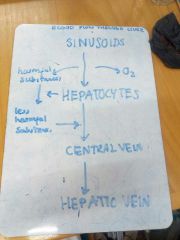
blood runs through sinusoids, past hepatocytes harmful substances and oxygen removed broken down by hepatocytes less harmful substances re enter blood blood runs to central vein and eventually ink up to form hepatic vein |
|
|
How are amino acids broken down by the liver? |
1. amino groups are removed from excess amino acids forming ammonia and organic acids- deamination 2. organic acids can be respired to give ATP or converted to carboyhydrate and stored as glycogen 3.ammonia is too toxic to excrete directly so is combined with CO2 in the ornithine cycle to make urea andwater 4. urea is released from the liver into the blood. kidneys then filter blood and remove urea as urine |
|
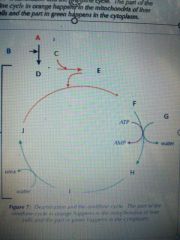
Name the substances a-b in the orthinine cycle |
A- amino acids B- delamination C- co2 D- ammonia E- carbamoyl phosphate F-citrulline G-aspartate H-arginiosuccinate I- arginine J- orthinine |
|
|
What is detoxification? |
breakdown of harmful substances into less harmful substances that can be excretes e.g alcohol broken down into ethanal and then to acetic acid by alcohol dehydrogenase hydrogen peroxide- hepatocytes contains enzymes that catalyse hydrogen peroxide splitting in to oxygen and water |
|
|
What is the function on the kidney? |
filter nitrogenous waste products out of blood maintain water balance |
|
|
Describe ultrafiltration in the kidneys |
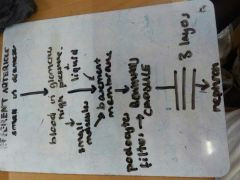
efferent arteriole smaller in diameter so blood in glomerous is under higher pressure forces liquid and smaller molecules out of capillary to bowmans capsule filtrate passes through 3 layers and enters nephron tubule larger molecules left in |
|
|
Descrive selective absorption in the kidneys |
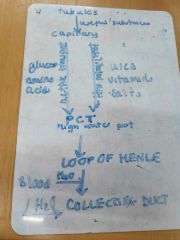
useful subsances enter capillaries from tubules epithelium of proximal convoluted tubule has microvilli so has large sa so move fast by facilitated diffusion (urea) and active transport water enters blood by osmosis- water potential of blood is lower than filtrate water is reabsorbed from the loop of henle and collecting duct |
|
|
How to kidneys regulate water potential when its too low in the loop of henle? |
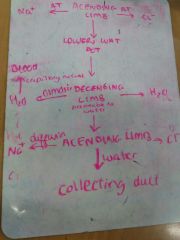
1.at ascending limb Na+ and Cl- ions are actively pumped out of the medulla 2. lower water potential in medulla, water moves out of descending limb by osmosis 3. by the bottom of the ascending limb, Na+ and Cl- diffuse out into the medulla, decreasing water potential 4. stages 1-3 increase ion concentration and lower water potential. water enters collecting duct by osmosis. water is reabsorbed through capillary network |
|
|
How does the posterior pituitary gland regulate water potential when water content of blood is too high? |
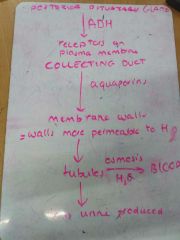
ADH released from gland binds to receptors on plamsa membrane of cells collecting duct aquaporins inserted in to membrane so walls are more permeable to water more water is reabsorbed from tubules in medulla and in the blood by osmosis smaller amount of urine is produced so less water is lost |
|
|
What is kidney failure? |
urea builds up in the blood=weight loss and vomiting fluid accumulates= swelling electrolyte imbalance= blood too acidic= brittle bones anaemia= kidneys make hormones that stimulates RBC high blood pressure-= protein in urine as Bowmans capsule damaged= blood in glucose |
|
|
Describe the process of kidney transplant |
new kidney implanted to replace damaged one has to be from person with same blood/ tissue type blood vessels joined and ureter inserted in to bladder |
|
|
What are the pros and cons of kidney transplantation? |
Pros -cheaper than dialysis -more convenient Cons -risk operation -can be rejected so have to take immunosuppressants as antigens on donor organs differ from patient which can prevent patient from responding efficiently to respond -last for 9 years |
|
|
How is kidney failure detected? |
measuring glomerular filtration rate -rate blood filtered from glomerus to bowmans capsule |
|
|
What are the types of dialysis? |
Peritoneal -uses peritoneal membrane in body -done at home Haemodialysis -uses machine -waste diffuses across a partially permeable membrane -takes 3-5 hours, twice a week -less risk of transplant |
|
|
How does haemodialysis work? |
-blood flows on onside of a partially membrane with dialysis fluid on the other side flow in opposite directions to maintain steep concentration gradient waste products and excess water and ions diffuse across the membrane into the dialysis fluid, removing them from the blood |
|
|
How do pregnancy test work? |
when urine is applied hCG binds to antibodies on beads urine moves through test strip carrying the coloured beads with it test has immobilised hCG antibodies if hCG is present strip turns blue because immobilised antibody binds to the blue beads if no hCG present beads pass through test area without binding. |
|
|
How are anabloic steroids tested in athletes? |
gas chromatography passed through column containing a polymer substances move at different speeds and separate mass spec converts to ions and then is analysed by a computer |
|
|
In what ways to plants respond to changes in the environment? |
-sense direction of light and grow towards it to maximise absorption for photosynthesis -sense gravity, so roots grow in right direction -climbing plants have sense of touch so can climb to reach the sunlight |
|
|
What is abiotic stress? |
anything potentially harmful that is natural but non living e.g drought or cold weather |
|
|
What is an example of a plant response to abiotic stress? |
carrots produce antifreeze proteins at low temperatures. Proteins bind to ice crystals and lower the freezing temperature of water to stop more crystals from growing |
|
|
What is herbivory? |
when plants are eaten by animals plants respond with chemical defences |
|
|
What are alkaloids? |
bitter tasting chemical noxious small kill/ deter herbivore e.g tobacco- produce nicotine which is poisonous to insects |
|
|
What are tanins? |
bitter tasting chemicals bind to proteins in gut so its hard to digest the plant |
|
|
What are pheromones? |
signalling chemicals produce a response in other organisms work by: alarming- causes nearby plants to start making tanins attracting-when corn plants are eaten by caterpillars, produce pheromones which attract parasitic wasps that eat the caterpillars
|
|
|
What other ways can plants respond to herbivory? |
folding up e.g- mimosa pudica when touched a signal spreads up the leaf causing it to fold up knocks off insects scare off animals |
|
|
What are auxins? |
stimulate growth of shoots by cell elongation produced by tips of shoots diffuse backwards down stem |
|
|
What is apical dominance? |
when auxins stimulate the growth of the apical bud and inhibit the growth of side shoots and lateral buds saves energy allows plants to grow tall fast to reach sunlight auxins become less concentrated as they move away from the apical bud so side shoots will start to grow at the bottom |
|
|
Name an example of an auxin |
indoleacetic acid (IAA) produced at tips and roots of flowering plants uneven distribution means there is uneven growth in plant |
|
|
What is gibberelinn? |
produced in young leaves stimulates seed germination cell elongation side shoot formation flowering inhibited by abscisic acid |
|
|
How do gibberellins stimulate seed germination? |
triggers breakdown of starch into glucose plant embryo uses glucose to respire and release energy needed to grow |
|
|
How do stomata close? |
abscisic acid binds to receptors on guard cell membranes
specific ion channels open Ca+ enters cytosol from vacuole K+ channels open K+ diffuse out water potential of cell increases water leaves guard cells by osmosis guard cells become flaccid so stomata close |
|
|
Define tropism? |
directional growth response to a stimulus |
|
|
Describe phototropism? |
growth of plant in response to light shoots are +ly phototropic grow towards light roots are -ly phototropic grow away from light |
|
|
Describe geotropism? |
growth of plants in response to gravity shoots are -ly geotropic grow away from gravity roots are +ly phototropic grow towards gravity |
|
|
Describe the following: hydrotropism thermotropism thigmotropism |
1.growth in response to water 2. growth in response to temperature 3. growth in response to contact with things |
|
|
Describe the peripheral nervous system |
somatic nervous system controls conscious activities autonomic nervous system controls unconscious activities made up of :sympathetic system- fight or flight, releases nor-adrenaline parasympathetic nervous system- rest and digest, releases acetylcholine
|
|
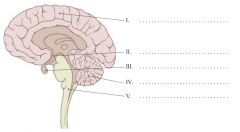
Name and describe the parts of the brain |
I. cerebrum- split in two hemispheres highly folded cortex vision, learning and thinking II. hypothalamus- maintains body temperature, produces hormones that control pituitary gland III. pituitary gland- releases hormones, stimulates other glands IV. cerebellum- muscle contraction, posture, balance V. medulla oblongate- automatically controls breathing and heart rate |
|
|
Define a reflex action |
when body responds to a stimulus without making a conscious decision to respond
is a protective action |
|
|
Describe the reflex arc when blinking |
STIMULUS- something touches your eye RECEPTORS- sensory nerve endings in cornea detect stimulus. nerve impulse sent along sensory neuron to relay across CNS CNS- impulse passes from relay to motor neurone EFFECTOR- motor neurone send impulse to orbiculan's oculi muscles that move lids RESPONSE- contract causing eyelids to close |
|
|
Describe the knee-jerk reflex |
STIMULUS- quadricep muscle stretches
RECEPTOR- stretch receptors detect stretch. nerve impulse passed along sensory neurone CNS- sensory neurone communicates with motor neurone in spinal cord EFFECTOR- motor neurone carries impulse to quadricep RESPONSE- quadricep muscle contracts so lower leg moves forward |
|
|
What is photosynthesis? |
a process where lights from the sun is harvested and used to drive the production of chemicals (ATP) and synthesise large organic molecules to smaller organic ones |
|
|
What is an autotroph? |
organism that synthesise their own organic food molecules from simple organic ones photoautotroph- uses light energy chemoautotroph- uses energy from exergonic chemical reactions |
|
|
What is ATP and where does it come from? |
getting energy directly glucose is not efficient ATP made from adenine, ribose sugar and three phosphate groups synthesised from ADP+inorganic phosphate Pi energy stored as chemical energy in the phosphate ATP synthase catalyses the reaction process called phosphorylation ATP diffuses to the part of the cell that needs energy |
|
|
Describe the properties of ATP |
releases small, manageable amount of energy at a time so no energy is wasted small, soluble so easily transported around in the cell easily broken down cant pass out of cell, so cell always has immediate source of energy |
|
|
What is substrate linked phosphorylation? |
ADP takes phosphate group from another molecule |
|
|
What is oxidative phosphorylation? |
ADP combines with free, unattached inorganic phosphate group using chemeosmosis |
|
|
Describe chemoisosmosis |
diffusion of protons from a region of high to low concentration through partially permeable membrane movement of protons releases energy used to attach Pi to ADP energy come from excited electrons which pass into electron transport chain made up of a series of e- carriers with lower energy levels which pump protons across membrane protons move back down concentration gradient through hydrophilic membrane channels linked to ATP synthase flow provides energy used to synthesise ATP |
|
|
What is the compensation point? |
Level of light intensity at which the rate of photosynthesis exactly matches the rate of respiration |
|
|
Where does photosynthesis take place? |
The chloroplasts |
|
|
Draw the structure of a chloroplast |
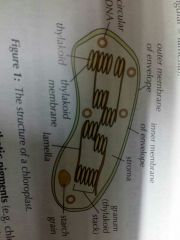
|
|
|
What are photosynthetic pigments ? |
Coloured substances that absorb the light energy needed for photosynthesis Found in thylakoid membranes |
|
|
Describe a photosystem |
Pigment attached to a protein
Photosytem I absorbs light at 700nm PSII absorbs light at 680nm
|
|
|
What is a primary pigment |
Primary pigments are reaction centres where electrons are excited during light dependent reaction.Usually chlorophyll a |
|
|
What are accessory pigments? |
Make up light harvesting systems Surround reaction centres Transfer light energy to them to boost energy available for electron excitement to take place |
|
|
What are accessory pigments? |
Make up light harvesting systems Surround reaction centres Transfer light energy to them to boost energy available for electron excitement to take place |
|
|
Describe the stroma of a chloroplast |
Gel like Contains enzymes, sugars, organic acids Contains chloroplast s own circular DNA Stores carbohydrates produced by photosynthesis as starch grains |
|
|
What is the light energy used for in the light dependent reaction? |
Makes ATP from ADP and Pi (photophosphorylation) Making reduced NADP from NADP Splitting water into protons, electrons and oxygen (photolysis) |
|
|
What is the light energy used for in the light dependent reaction? |
Makes ATP from ADP and Pi (photophosphorylation) Making reduced NADP from NADP Splitting water into protons, electrons and oxygen (photolysis) |
|
|
What are the two processes that occur in the light dependent reaction of photosynthesis? |
Non cyclic phosphorylation Cyclic phosphorylation |
|
|
Describe non cyclic phosphorylation |
1. Light energy absorbed by PSII. Excites electrons in chlorophyll Electrons move to higher energy level Move along electron transport chain to PSI 2. The electrons leaving PSII need to be replaced Light energy splits water into H+ , electron and oxygen H2O--> 2H+ +1/2O2 3. Excited electrons lose energy as they move along electron transport chain Energy used to transport H+ into thylakoid via membrane proteins called protein pumps Thylakoid has higher concentrations of H+ than stroma H+ move down concentration gradient into stroma via ATP synthase Energy from movement combines ADP and Pi =ATP 4.Light absorbed by PSI Excites electrons to higher energy level Electron transfered to NADP with a proton from the stroma to form reduced NADP |
|
|
Draw a diagram summarising no cyclic phosphorylation |
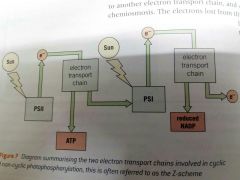
|
|
|
Describe cyclic photophosphorylation |
Electrons leaving electron transport chain after PSI can be returned PSI leads production of ATP without electrons being supplied Reduced NADP not produced |
|
|
Draw a diagram summarising the light dependent stage of photosynthesis |

|
|
|
Draw a diagram summarising the light dependent stage of photosynthesis |

|
|
|
Describe the light independent reaction |
CALVIN CYCLE 1. CO2 enters leaf through stomata and diffuses into stroma Combined with RuBP Produces an unstable 6C compound Breaks down in to 2 GP molecules with 3C Catalysed by RuBisCO 2. 2GP'S reduced to TP ATP provides energy Required H+ from NADP NADP recycled 3. 5/6 TP aren't used to make useful organic compounds Regenerate RuBP Uses up rest of ATP produced by light dependent reaction |
|
|
Describe the light independent reaction |
CALVIN CYCLE 1. CO2 enters leaf through stomata and diffuses into stroma Combined with RuBP Produces an unstable 6C compound Breaks down in to 2 GP molecules with 3C Catalysed by RuBisCO
2. 2GP'S reduced to TP ATP provides energy Required H+ from NADP NADP recycled
3. 5/6 TP aren't used to make useful organic compounds Regenerate RuBP Uses up rest of ATP produced by light dependent reaction Needs to turn 6 times to make one hexosr sugar |
|
|
Draw the Calvin cycle |

|
|
|
How are to produces of the Calvin cycle used to make organic substances? |
Carbohydrates - hexose sugars made from two triose phosphate molecules Lipids- made from glycerol synthesised from triose phosphate, and fatty acids from GP Amino acids- GP |
|
|
What are the optimum conditions for photosynthesis? |
1. High light intensity at a certain wavelength- photosynthetic pigments can only absorb red and blue light 2. Temperature around 25 If temp is below 10' enzymes becomes inactive Temp above 45- enzymes denature High temps- stomata close to avoid losing water Thylakoid membrane damaged reducing sites for e transfer Chloroplast membrane damaged releasing Calvin cycle enzymes into cell Chlorophyll damaged- reducing amount if pigment that can absorb energy 3. Carbon dioxide at 0.4% any higher stomata start to close |
|
|
What are the limiting factors of photosynthesis? |
Light intensity Temperature CO2 concentration Water stress |
|
|
How is plant growth increased in glass houses? |
Carbon dioxide added to air by burning propane in CO2 generator Light can get through glass Lamps at night Trap heat energy from sunlight Heating and cooling systems keep optimum temperature |
|
|
How is plant growth increased in glass houses? |
Carbon dioxide added to air by burning propane in CO2 generator Light can get through glass Lamps at night Trap heat energy from sunlight Heating and cooling systems keep optimum temperature |
|
|
What are the limiting factors of the Calvin cycle |
Light intensity- when low products of light dependent stage are in short supply Conversion of GP to TP and RuBP Level of GP will rise but isn't being used up quickly Temperature- low temps enzymes are inactive so RuBP GP and TP levels fall CO2 concentration- less CO2 to combine with RuBP to make GP |
|
|
Name the four stages of respiration |
Glycolysis Link reaction Krebs cycle Oxidative phosphorylation |
|
|
Describe glycolysis in respiration |

Glucose phosphorylated by adding phosphate from ATP Creates 1 hexose phosphate and 1 ADP HP phosphorylated by ATP to form hexose bisphosphate and ADP HBP split up into 2 triose phosphates Triose phosphate is oxidised forming 2 molecules of pyruvate NAD collects H+ ions forming 2 reduced NAD 4 ATP produced |
|
|
What are the products of glycolysis and where are they used? |
2 reduced NAD to oxidative phosphorylation 2 pyruvate to Link reaction 2 ATP for energy |
|
|
Describe the link reaction in respiration |

Pyruvate actively transported into matrix of mitochondria Pyruvate is decarboxylated NAD is reduced Pyruvate changes to acetate Acetate combines with coenzyme A Forms acetyl CoA |
|
|
What are the products of the link reaction and are where are they used? |
2 acetyl coenzyme A- to Krebs cycle 2CO2 release as waste 2 reduced NAD to oxidative phosphorylation |
|
|
Draw the Krebs cycle |
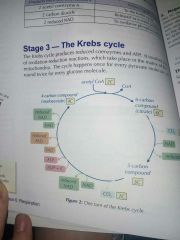
|
|
|
What are the product s of the Krebs cycle and where are they used? |
1 CoA reused in next link reaction Oxaloacetate - regenerated for next Krebs 2 CO2- released as waste product 1 ATP used for energy 3 reduced NAD to oxidative phosphorylation 1 reduced FAD to oxidative phosphorylation |
|
|
Draw oxidative phosphorylation |
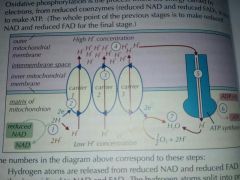
|
|
|
How many molecules of ATP is produced from one molecule of glucose in aerobic respiration? |
32 |
|
|
What is anaerobic respiration ? |
Respiration without oxygen |
|
|
What is lactate fermentation |
Occurs in mammals Produces lactate Reduced NAD transfers hydrogen to pyruvate to form lactate and NAD NAD then reused in glycolysis lactate and NADNAD then reused in glycolysisLactate taken up by liver and converts into back to glucose in gluconeogenesis Lactate taken up by liver and converts into back to glucose in gluconeogenesis |
|
|
What is alcoholic fermentation? |
Occurs in yeast cells Produces ethanol CO2 removed from pyruvate to form ethanal Reduced NAD transfers hydrogen to ethanol to form ethanol and NAD NAD reused in glycolysis |
|
|
What is a respiratory substrate? |
any biological molecule that can be broken down in respiration or release energy |
|
|
What is a respiratory substrate? |
any biological molecule that can be broken down in respiration or release energy |
|
|
What is the respiratory quotient and how do you work it out? |
RQ= vol of CO2 released/ vol of O2 consumed |

